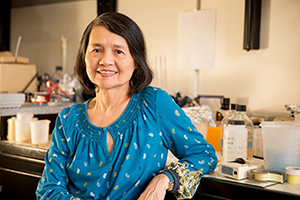Study Reveals How Lethal Dart Frogs Avoid Poisoning Themselves
 |
|
The golden poison dart frog. (Photo courtesy of Wiki Commons)
|
ALBANY, N.Y. (Sept. 28, 2017) – Known as one of the deadliest animals in the world, adult golden poison dart frogs (Phyllobates terribilis) are loaded with a lethal amount of batrachotoxin (BTX) in their skin glands.
How lethal? Enough to kill 20,000 mice or 10 humans.
It turns out these Colombian frogs do not create the toxin themselves. Instead, it’s diet-based. By eating beetles and other insects, the frogs produce about one milligram of BTX for self-defense. If moved into captivity, they become completely harmless.
This has left scientists wondering how the frogs stay safe from their own toxin – until now.
In a new study, University at Albany biologists Sho-Ya Wang and Ging Kuo Wang inserted five naturally occurring amino acid replacements found in the frog’s muscles into the inner cavity of rat muscle sodium channels. These specific amino acids were identified in a previous University of Texas-Austin study.
By doing so, the researchers found that the rat muscle became immune to the effects of BTX. The next step was to test each amino acid individually until they found which were actually responsible for the BTX immunity – it was only one, N1584T.
The finding suggests that the immunity for the frogs come from just a single genetic mutation.
 |
|
Sho-Ya Wang, professor in the Department of Biological Sciences. (Photo by Carlo de Jesus)
|
“As a biologist, I’ve always been interested in how this dart frog, one of the most poisonous animals on earth, could possibly avoid batrachotoxin self-intoxication, said Sho-Ya Wang, a professor in UAlbany’s Department of Biological Sciences. “To study this question, we decided to address the role of five unique amino acids replacements within the inner cavity of P. terribilis muscle sodium channels. Our results indicate that only one of the amino acids is required to confer batrachotoxin autoresistance.”
Unfortunately, BTX currently has no antidote, and this discovery is not likely to help those who are poisoned by the frog’s toxin. It may, however, offer the potential for advancements in a number of targeted drug therapies.
“The receptors for local anesthetics, antiarrhythmics, and anticonvulants medications overlap with the receptor for BTX within the inner cavity of our sodium channel,” said Ging Kuo Wang, a volunteer researcher in UAlbany’s Department of Biological Sciences, who recently retired from Harvard Medical School and Brigham and Women’s Hospital. “The mapping of these drug/toxin binding sites and the deep understanding of the topology of the inner cavity are important for the design of novel therapeutics.”
The researchers said the next steps will be to test the resistance of the amino acids to other toxins – including veratridine and aconitine, both plant neurotoxins that also target the inner cavity of the sodium channel.
They also plan to further study why the golden poison frog builds a stronger resistance to BTX than the lab-made rat muscles.
“One thing we’ve found is that the golden poison frog finds a better way of making the batrachotoxin-resistant sodium channels,” Sho-Ya Wang said. “Our man-made mutants consistently exhibited abnormal sodium channel functions or did not express as well as the frog-derived mutants did. We want to learn how nature is finding a better way to create the BTX-resistance.”
This study was recently published in the Proceedings of the National Academy of Sciences (PNAS). You can read more in Chemical and Engineering News.
Learn more about Professor Wang’s research and expertise here.
![]() For more news, subscribe to UAlbany's RSS headline feeds
For more news, subscribe to UAlbany's RSS headline feeds
A comprehensive public research university, the University at Albany-SUNY offers more than 120 undergraduate majors and minors and 125 master's, doctoral and graduate certificate programs. UAlbany is a leader among all New York State colleges and universities in such diverse fields as atmospheric and environmental sciences, business, education, public health,health sciences, criminal justice, emergency preparedness, engineering and applied sciences, informatics, public administration, social welfare and sociology, taught by an extensive roster of faculty experts. It also offers expanded academic and research opportunities for students through an affiliation with Albany Law School. With a curriculum enhanced by 600 study-abroad opportunities, UAlbany launches great careers.


